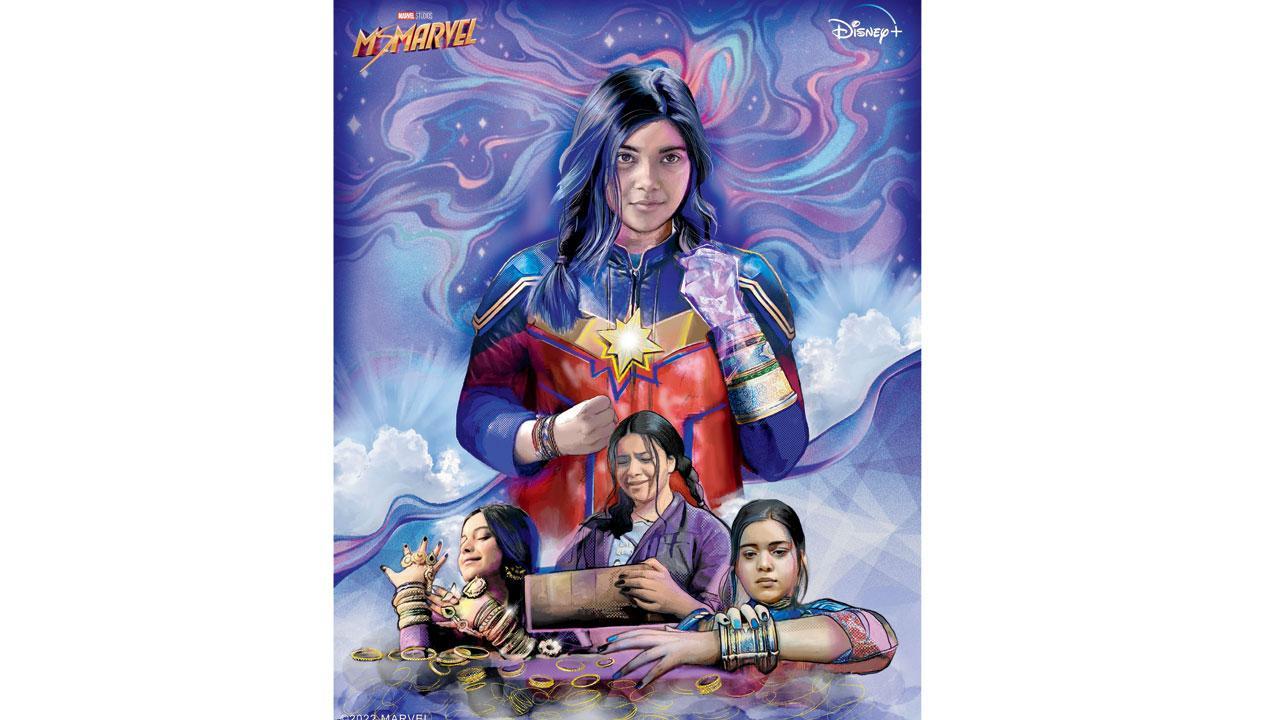As Marvel’s initial brownish-red superhero resonates with South Asian communities opposite India and a rest of a world, we pronounce to an artist who collaborated with a party height to emanate an design that highlights a show’s informative significance

The artist’s Ms Marvel artwork. Pic Courtesy/Neha Kapil, 2022 Marvel
Even today, false stereotypes continue to impede suggestive interactions with and an bargain of communities. This is because a picturesque description of enlightenment in Ms Marvel, a initial brownish-red superhero in a Marvel Cinematic Universe, has already found recognition among audiences. The impression Kamala Khan, played by actor Iman Vellani, is a Pakistani Muslim teen from New Jersey and is zero like any informative classify customarily subjected to a South Asian diaspora and women.
Promotions of a uncover enclosed commissioning South Asian artists to emanate artworks that prominence aspects of a uncover that resonated with them. From a gifted lot is Neha Kapil, an Indian-American visible artist and conform engineer formed in Los Angeles.
Embracing a culture
Kapil says, “It’s an sparkling time where South Asian-American stories are finally being recognized and valued. we was blissful that a height directly approached creators who bond to a practice in a array to assistance tell a universe because a enlightenment matters.” With usually 5 days to finish a artwork, Kapil’s vital concentration was on a messaging, and so a print majorly enshrines dual elements — bangles, and a line by Kamala’s mom from a initial episode:

Neha Kapil
“Are we a vast head-in-the-clouds form person?” Kapil expresses how relatable it is that in many brownish-red households children are directed towards required pursuits and careers. “You have to be a bit of a romantic even when multitude tells we to concentration on some-more unsentimental things. Being an artist myself, we connected with Kamala’s titillate to follow her passions and infer that what she loves shouldn’t be discharged as unrealistic,” a artist tells us.
She records a significance placed on bangles, saying, “As a South Asian woman, early memories of my enlightenment branch from watching a trinket my mom had, wearing it and receiving identical equipment from kin in India.” South Asian enlightenment and conform like bangles mount out not only in her poster, though via Kapil’s art that she says gives her work meaning, only as it acts as a source of Kamala’s strength.
The print goes over a area of fan art with Kapil’s goal to share her enlightenment and etch how a South Asian diaspora navigates and embraces dual worlds. “Every brownish-red lady flourishing adult in a US has a specific impulse where something about a birthright strikes a cord and feels special, either that’s a gift, a initial Bollywood movie, celebrations or traditions. This is because we wanted Kamala’s tie to bangles to be a focal indicate of my piece,” a artist elaborates.
Representation matters
Emphasising on a significance of illustration in mainstream media, Kapil maintains that not saying someone like yourself being distinguished on shade in a certain light plays a purpose in steering viewers to secretly trust that they aren’t honourable of respect, adore and opportunities, or that there isn’t some-more to a village than a stereotypes combined surrounding them. “The best thing we can do is to make a people around us feel seen, heard, and understood, and by media and art, encourage that each story matters,” Kapil signs off.
Log on to: @itsnehalicious

<!–
$(“.read-more-my”).click(function() {
$(this).parent().siblings(“.more-text”).css(‘display’, ‘block’);
$(‘.article-first-para’).removeAttr(“style”);
$(this).parent().remove();
var height12=$(‘#showfullarticle’).offset().top();
$(window).scrollTop(height12);
(function(i, s, o, g, r, a, m) {
i[‘GoogleAnalyticsObject’]=r;
i[r]=i[r]||function() {
(i[r].q=i[r].q||[]).push(arguments)
}
, i[r].l=1*new Date();
a=s.createElement(o), m=s.getElementsByTagName(o)[0];
a.async=1;
a.src=g;
m.parentNode.insertBefore(a, m)
}
)(window, document, ‘script’, ‘//www.google-analytics.com/analytics.js’, ‘ga’);
//ga(‘create’, ‘UA-2326030-39′, ‘auto’);
let displayMode = ‘browser';
let dimensionValue=”browser”;
const mqStandAlone = ‘(display-mode: standalone)';
if (navigator.standalone || window.matchMedia(mqStandAlone).matches) {
if(displayMode==’standalone’){
ga(‘create’, ‘UA-213337986-1′, ‘auto’);//pwa
}else{
ga(‘create’, ‘UA-2326030-39′, ‘auto’);//live
}
}
ga(‘send’, ‘user’);
ga(‘send’, {
‘hitType':’event’, ‘eventCategory':’Showfullstory’, ‘eventAction':’user’, ‘eventLabel':’article’, ‘hitCallback':function() {}
, ‘hitCallbackFail':function() {}
});
});
–>
